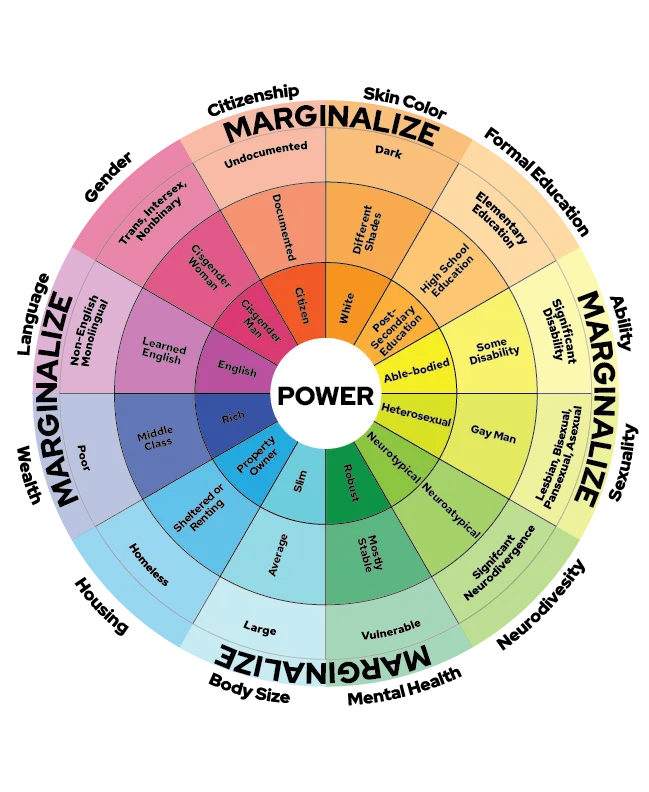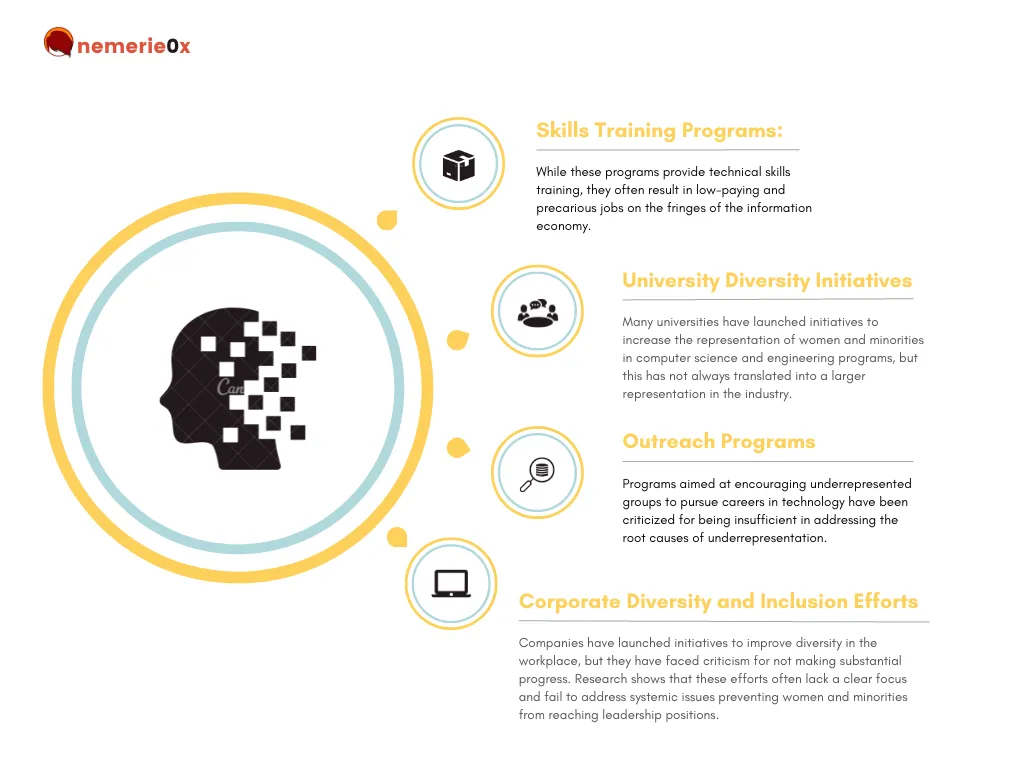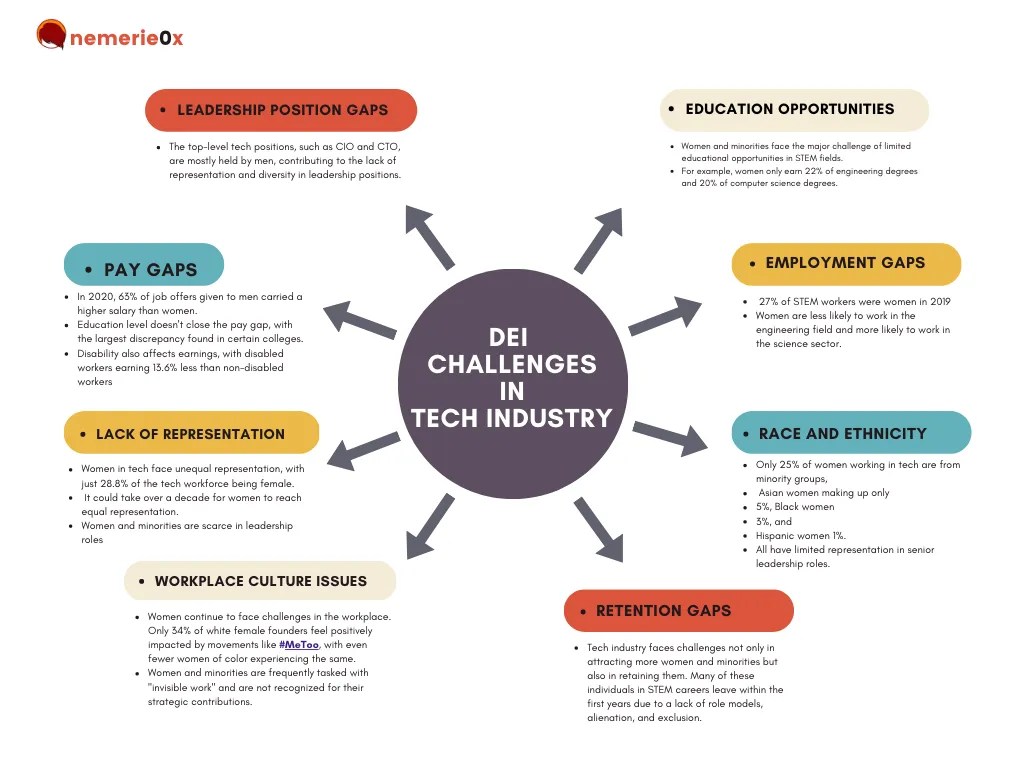The Tech Industry’s DEI Dilemma and the Path Forward in Web3.

Imagine a world where the Internet truly embodies diversity and representation. In the web3 industry, women and minorities are not just token figures but leaders and innovators driving the industry forward.
While the tech industry still faces the challenge of underrepresentation, web3 is providing a platform for diverse voices to be heard and recognized. Join me on a journey to uncover both the triumphs and ongoing challenges of diversity, equity, and inclusion in the exciting world of web3.
Author: Aimara García Cabezas
1. The Basics of Web3
The term “web3” has been buzzing around in recent years, but what exactly does it mean, and where did it come from? To understand the concept of web3 it’s crucial to first look back at the history of the Internet and its several stages. Figure 1 resumes the main elements of each phase.

Note: this illustration of the different phases of the internet is an oversimplification because each iteration on the web has immense overlap and exists in tandem. The web is constantly evolving, and the different iterations and their characteristics are not mutually exclusive.
The “Read-only” Web
Web 1.0 is also known as the original version of the Internet. The innovator of the World Wide Web, Tim Berners-Lee, referred to this phase as the “read-only”.
-
Static pages
-
Era lasting from 1990 to the early 2000s
-
Defined as the “web of information economy”
The Era of User-generated Content
With the advent of Web 2.0, we saw a shift towards the “platform economy”:
-
User-generated content
-
Ease of use
-
Interactivity
-
Improved compatibility with other systems and devices
This era emphasized participation and contribution rather than just reading. This was (still is) the rising period of the so-called “big tech” or “tech giants”, who collect and sell our private data as a super lucrative business.
The dawn of a new era
Web3 is the start of a new era, driven by frustration with powerful centers, lack of government transparency, big tech restrictions, and distrust in media. This era is powered by the evolution of a (not-so-new) technology rooted in cryptography and privacy.
-
A change to the decentralized applications
-
A more user-centric web
-
Includes concepts like blockchain tech, big data, DAOs, artificial intelligence (AI), machine learning, or token-based economies.
-
Hello, “creator economy”!
The impact of web3
The power of web3 lies in our hands, and it’s up to us to shape its impact on the world. Web3 is often compared to the birth of electricity and is a powerful catalyst with the potential to revolutionize our lives, work, and interactions with each other. However if it is not implemented with equity, diversity, and inclusion as its core values, it could deepen the problems our society already faces. It’s important to remember that web3 is still an experiment and not a magical solution to all problems. In the end “Web 3 is a movement. It’s not just about technology, it’s about people”.
2. Clarifying critical concepts and the scope of this article
Let’s begin by briefly delving into the vital concepts of diversity, equity, inclusion, representation, and underrepresentation from a more global perspective as they relate to the web3 industry and set the scope of this article.
From my viewpoint diversity, means acknowledging and appreciating the unique qualities that make each person unique, not just in terms of race or gender but in all aspects of their identity. Equity involves working toward eliminating systemic barriers and creating equal opportunities for all groups. Inclusion requires creating a supportive and inclusive environment where everyone feels valued and heard. Representation ensures that diverse perspectives and experiences are accurately reflected in the industry. **Underrepresentation, **on the other hand, is a consequence of a lack of representation and inhibits progress toward inclusion and equity in tech.
As we embark on this journey of discovery, we need to understand the relationship between these concepts and the power dynamics that contribute to underrepresentation. Figure 2 can help us navigate this complex landscape to broaden our perspective.

Inherited issues and the impact on Web3
The growth of web3 has opened up new doors for diversity and inclusivity, despite the facts exposed in studies pointing toward the underrepresentation of women and minorities in the web3 community. It is essential to acknowledge that, as we’ll see later in this article, this issue derives from long-standing systemic challenges in the tech industry. At the core of this invisibility lies the attrition faced by women and minorities in tech, which unfortunately also extends to the web3 realm.
However, it is imperative not to ignore the effort and progress made by women and minorities who lead and found web3 projects. That’s why this article aims to boost their job and suggests learning from their experience handling the underrepresentation problem.
3. Breaking the cycle of inherited inequity
“If you think women in tech is just a pipeline problem, you haven’t been paying attention”
The tech industry is known for its boy culture and can be a hostile environment for marginalized groups. Focusing only on getting individuals into the training pipeline ignores systemic bias in hiring and promotion, reinforces narrow views of merit and skill, and fails to address the high attrition rate experienced by these groups in the industry.
Efforts to promote diversity, equity, and inclusion in the tech sector have been ongoing for years. However, despite initiatives aimed at increasing the representation of women and minorities, underrepresentation remains a reality. Figure 3 summarizes some classifications of the programs that have failed to address this issue effectively.

Underrepresentation challenges in tech, beyond statistics
We must go beyond statistics to take concrete actions. Inactivity only prolongs the problem and prevents the industry from achieving genuine representation. The challenges faced by women and minorities in the tech industry go beyond just gender and race, and addressing this underrepresentation problem requires more than just exposing statistics.
While recognizing the representation deficit in the tech industry is a starting point, it is far from enough. Studies, such as the one summarized in Figure 4, provide valuable insights into the reality faced by these groups. Still, it is vital to acknowledge that the solution to underrepresentation is much more complex.

4. Making waves in a sea of invisibility
No matter what, all efforts seem insufficient against a narrative leaning more toward invisibility than giving these women and minority-led projects and organizations the recognition and prominence they deserve in the web3 space.
Despite their innovative solutions and strong communities, they struggle to break through the current invisibility trend.
It’s time to shine a light on the fantastic work these trailblazers are doing. Down is an unfinished list of some of these remarkable projects and organizations. 👇🏻👇🏻👇🏻
Why boost the visibility of women and minorities leading projects in web3?
Raising the visibility of women and minorities leading projects in web3 is crucial for several reasons like those explained in Figure 5.

Is admirable how these projects and communities are actively building inclusive structures and processes, not just criticizing the past but learning from it. The web3 community should focus more on studying their use cases and the contributions they bring to the struggle for representation in a natural way. Rather than continue paying attention to statistics reflecting nothing new.

There will come a time when we overcome this narrative of invisibility and shift to new ways of coordinating and increasing funding for projects to promote development and create sustainable ways of living well, all together.
About the author

I am a passionate web3 content creator and DEI advocate with a unique perspective on the decentralized world. As a Cuban woman with expertise in economics, business, education, and writing, I craft stories through my cultural lens to inspire Latin American women in web3 and increase visibility for underrepresented communities.
My core values of personal integrity, holistic well-being, creativity, and authenticity guide me as I promote diversity, equity, and inclusion in the web3 ecosystem. Through storytelling, community-building, and authentic human connections, I strive to develop a creative and inclusive web3 space where all voices are heard and valued.
Join me in forging new paths and embracing diversity, equity, and inclusion as core values in the web3 world.
You can contact me via mail via LinkedIn or follow me on Twitter (@nemerie0x).